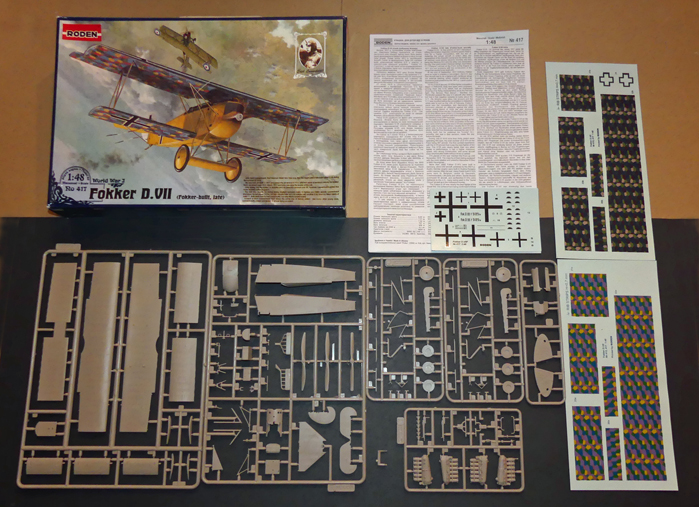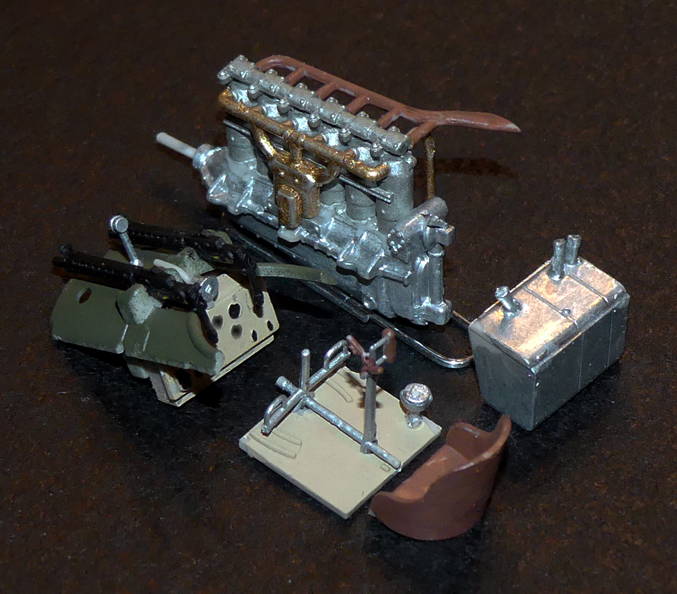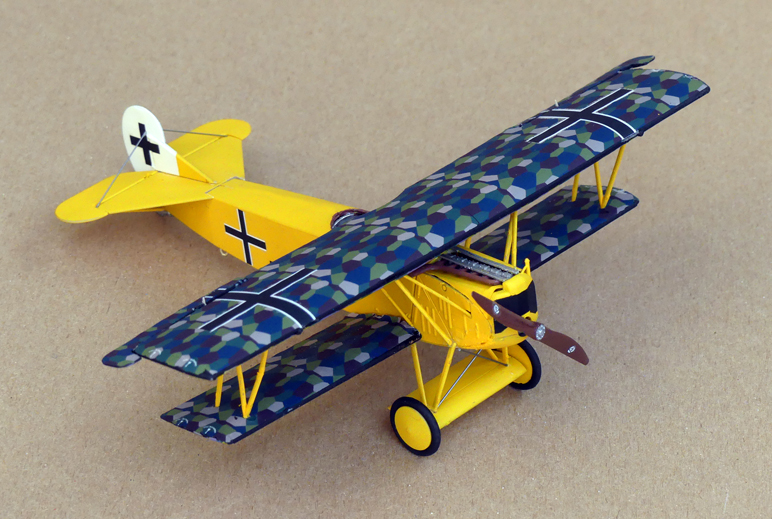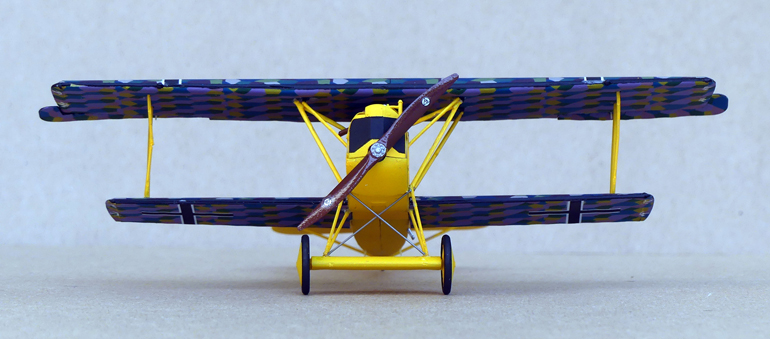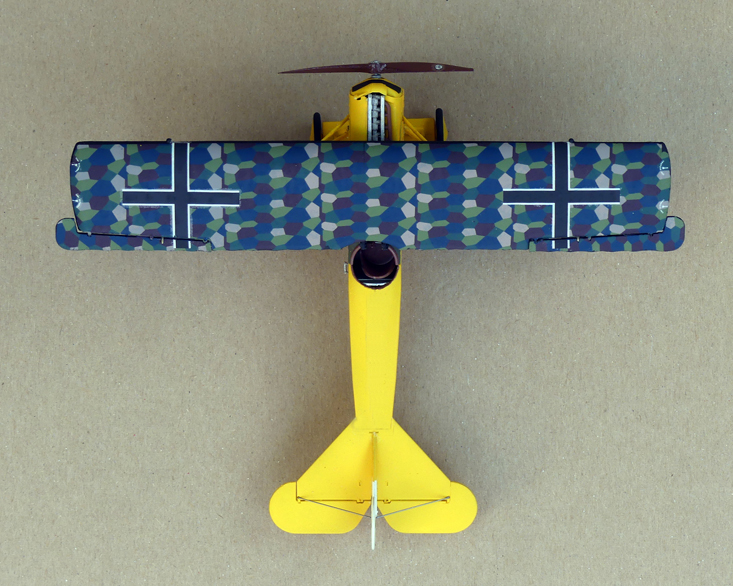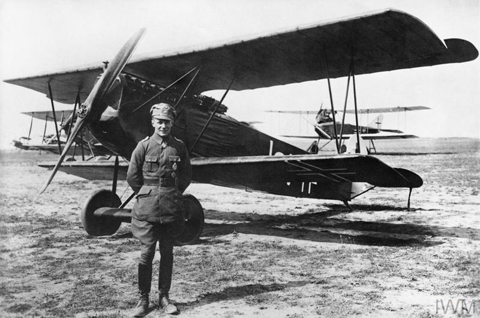 <><>
<><>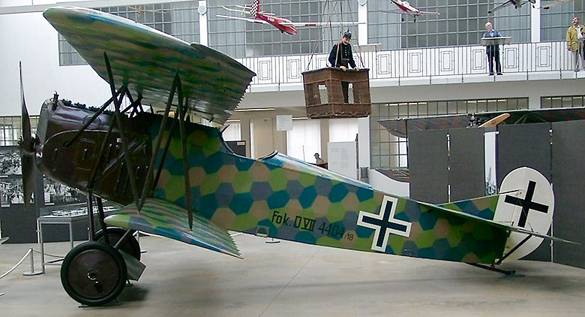
 <><>
<><>
During the First World War, the Dutchman Anthony Fokker was building airplanes in Germany. His first factory was located at the Johannisthal airfield, near Berlin. In 1913 he moved to Schwerin. A lot of different types were designed and built there, among which were the famous ‘Eindecker’ series, and the Dr.I triplane. At the end of 1917, Fokker was out of the picture as supplier for fighter aircraft.
Building of the prototype of what was to become the Fokker D.VII started in December, 1917 in the Fokker factory at Schwerin. At that time, Reinhold Platz was working as designer. The designation for this type was V.11, which stands for Versuchsmachine no. 11 (Experimental aircraft No. 11). This V.11 had a number of novelties that included a car-type radiator in front of the engine and cantilever wings with no external bracing wires, which made for a very clean appearance.
At the end of January, 1918, the first competition for D class machines was held at Adlershof. In this competition, German pilots from the front flew in new types to test them and choose which one would be produced for the front. In this first competition the V.11 came out as the ultimate winner, and was designated D.VII.
Fokker was awarded large contracts for the aircraft that was to become the D.VII. Because the Fokker factory at Schwerin did not have the capacity to build large numbers of the plane, Fokker’s rival Albatros had to manufacture the D.VII under license. Eventually they were built by the Albatros factories at Johannisthal and the Ostdeutsche Albatros Werke at Schneidemühl. Fokker received a 5% fee from Albatros for every D.VII they build. The total number of D.VII’s built is unknown, but production is estimated over 3,000 by all three factories.
In service with the Luftstreitkräfte, the D.VII quickly proved itself to be a formidable aircraft. When the Fokker D.VII appeared on the Western Front in April 1918, Allied pilots at first underestimated the new fighter because of its squarish, ungainly appearance but quickly revised their view. The type quickly proved to have many important advantages over the Albatros and Pfalz scouts. Unlike the Albatros scouts, the D.VII could dive without any fear of structural failure. The D.VII was also noted for its high maneuverability and ability to climb, its remarkably docile stall and reluctance to spin. It could "hang on its prop" without stalling for brief periods of time, spraying enemy aircraft from below with machine gun fire.
Notable pilots who flew the D.VII include Hermann Göring (who replaced Manfred von Richthofen as commander of Jagdgeschwader 1, known as the Flying Circus after “the Red Baron” was shot down and killed), Ernst Udet and Erich Loewenhardt who was the 3rd highest German flying ace with 54 victories during the First World War, behind only Richthofen and Udet. During World War II, Göring went on to become Reichsmarschall and Commander-in-Chief of the Luftwaffe and Udet was a Luftwaffe Colonel-General. The photo above on the left is of Ernst Udet beside his Fokker D.VII nicknamed "Lo".
Facts and General Characteristics of the Fokker D.VII:
Contractor: Fokker-Flugzeugwerke, Germany
Type: Fighter
Crew: One
Wingspan: 29 ft. 2 in. (8.9 m)
Length: 22 ft. 10 in. (6.95 m)
Height: 9 ft. 0 in. (2.75 m)
Weight: Empty 1,477 lbs. (670 kg), Gross 1,997 lbs. (906 kg)
Power Plant: 1 × Mercedes D.III 6-cyl. water-cooled in-line piston engine, 160 hp (120 kW)
or 1 × Mercedes D.IIIa 6-cyl. water-cooled in-line piston engine, 175 hp (130.5 kW)
or 1 × BMW IIIa 6-cyl. water-cooled in-line piston engine 185 hp (137.95 kW)
Max Speed: 117 mph (189 km/h), with BMW IIIa engine – 124 mph (200 km/h)
Range: 165 miles (266 km)
Ceiling: 20,000 ft. (6,000 m)
Armament: 2 × 0.312 in. (7.92 mm) LMG 08/15 "Spandau" machine guns
Facts and General Characteristics of the Model:
This model has the paint scheme, lozenge camouflage and markings of the Fokker D.VIIF flown by Erich Loewenhardt while assigned to Jasta 10, Puisieux Ferme, August 1918.
Manufacturer: Roden, Ukraine
Scale: 1/48
Wingspan: 7.3”
Length: 5.8”
Height: 2.2”
Parts: 77 plus 2 control and 2 support wires
Decals: 35
Hours to build and paint: 26.5
Mistakes/Problems: This was my first model manufactured by Roden. It’s pretty detailed but the instructions were hard to follow in a few places. The large wing lozenge camouflage decals took a lot of work and turned out well but many parts didn’t fit correctly and had to be filed or modified. I broke one of the wing supports and couldn’t completely fix it, and many of the parts ended up crooked or out of alignment. Roden didn’t know the serial number of Loewenhardt’s airplane but I wanted to show one so I used Göring’s serial number.
